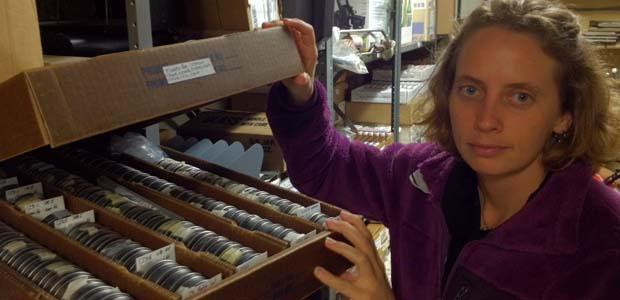Research suggests ocean garbage patches may be bigger than once believed
Mary Engels with the Sea Education Association shows off the agency’s collection of plastic collected from the earth’s oceans. Some samples date back 40 years. (Photo by Sabri Ben-Achour.)
Those huge floating garbage patches out in the middle of the ocean may be a lot bigger than anyone though.
Researchers think there’s a whole lot more plastic in the ocean — most of it is just hidden from view.
In Marvin Gaye Park in Washington, D.C., there’s a trash trap over the creek that skims the surface for floating trash. There’s a plastic water bottle, an ice cream container, a potato chip bag, a beer can. All in all, the trap catches about 800 pounds of trash a month.
But over almost all the other streams in the area, there are no trash traps. In most streams, trash like this will float into the river and out into the ocean. A tiny bit of it might end up in the plastic archive collection, at the Sea Education Association in Woods Hole, Mass. The rest will remain in the ocean.
Mary Engels, the association’s science coordinator, pulls out a little shoe polish-like tin and points to the dozens of tiny pieces of plastic inside.
“These samples were taken in the Sargasso Sea to the east of Bermuda,” Engels said.
The Sargasso Sea is about a thousand miles out in the Atlantic, part of what’s called a subtropical gyre — a giant swirl of calm water near the equator. The earth has five big ones, each thousands of miles across. The way the planet spins and the currents flow, the gyres end up collecting all kinds of trash.
Sea Education Association researchers skimmed the surface of the North Atlantic gyre with a meter-wide net for about a mile. They came up with blue, green, and white plastic specks, pieces of opaque sheet plastic, even plastic fibers.
It’s hard to tell by looking at the bits what they once were or where they came from, but Giora Proskurowski, a research scientist at the University of Washington who’s worked with the association, has a pretty good idea. There’s a lot of polypropylene, Proskurowski says, which is in a lot of fishing gear, like lines and nets. Clothing often contains polypropylene as do yogurt containers. Another source of pollution is polyethylene, which is what makes plastic bags. Plus, of course, there’s plenty of Styrofoam.
Proskurowski says most of the contaminants in the North Atlantic, come from the United States, Europe, as well as countries around the Gulf of Mexico and Caribbean Sea.
Each one of the five, big oceanic gyres sucks in trash from the countries along the surrounding coast. Scientists have known about these giant swirls of trash for years, but Proskurowski says there is probably much more of it than anyone ever thought, because most of it is usually swirling below the surface.
Proskurowski’s “aha” moment came when he was in the middle of the North Pacific gyre.
“The surface of the ocean was flat calm, (and) all of a sudden I saw hundreds of thousands of little tiny pieces of white and blue plastic. It was like when a photograph comes into focus perfectly, and everything just pops out,” Proskurowski said. “And as soon as the wind started kicking up, within a half an hour you could no longer see those plastic pieces.”
Proskurowski went on to research this, and found that the wind was pushing the garbage down in the water column.
“After that we started doing subsurface tows, where we towed three meters below the surface, five meters below the surface, and on every one of those tows I caught plastic,” he said.
There is conflicting research from different oceans, but one recent survey by researchers at the Scripps Institution of Oceanography in San Diego found that the amount of plastic in the North Pacific has increased by 100 times over the last four decades.
But despite the huge influx, Scripps graduate student Miriam Goldstein says there is no “island” of trash.
“There’s this misconception that there’s a big floating garbage dump you can see and walk on. But actually, most of the plastic is really small.”
So what then is the big deal?
Goldstein says when it comes to plastic trash in the oceanic gyres, small is probably worse than big, “because if there was an island, it’d be easy to fix–send a barge out there, pick it up, done.”
The problem is that marine animals and sea birds eat this plastic. SEA’s Karen Lavender Law, who’s collaborated with Giora Proskurowski, has seen it first hand.
“We brought aboard this beautiful fish,” Law said, “and in the name of science we dissected it, and in the name of dinner we filleted it, and in the gut there was some piece of plastic, gridded material two by three inches in size.”
It’s worrisome because plastics can gum up an animal’s systems. Law says they also act like sponges for more harmful persistent pollutants like PCB’s, which they then transfer to animal’s fatty tissue. And the plastics themselves can break down into harmful chemicals.
There’s little data on exactly what all this plastic is doing to ocean going life. But researcher Proskurowski says the presence of any plastic is important.
“When you’re 2,000 miles away from land and can dip your net in the water and get 200 pieces of plastic, that seems insane to me,” Proskurowski said. “It’s like going to the very farthest part of the Amazon and seeing plastic bags in every single tree.”
That’s something to think about, Proskurowski says, next time you buy something in a plastic bag or toss out a plastic bottle.
